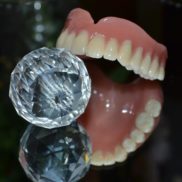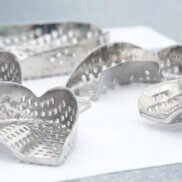- Dentures
- Prosthodontics
There are a number of options for replacing or reshaping teeth with dentures:
Fixed dentures
Dental crown
A dental crown is used to repair a severely decayed tooth to ensure its strength for mastication and resistance to wear. Dental crowns support the remaining tissue and reduce its risk of breaking.
We mainly use ceramic materials to produce the crowns on site at our clinic with the help of the Cerec CAD/CAM system. For more information, read the article “Ceramic crowns and fillings”.
Veneer
A veneer is a thin layer of ceramic material placed over a tooth that creates a beautiful, more uniform and brighter smile.
Veneer can be used to cover a tooth that is:
- stained, e.g. due to medications;
- cracked;
- uneven in shape or appearance, etc.
It is often beneficial to cover several adjacent teeth, as then the veneers can be colour matched better and the row of teeth will be more uniform in shape.
It is not recommended to apply veneers to teeth that have undergone root canal treatment. Teeth with treated root canals should be crowned.
We produce veneers in our clinic using the Cerec CAD/CAM system. For more information, read the article “Ceramic crowns and fillings”.
Bridge
A bridge is a fixed dental prosthesis that is used to replace one or more missing teeth.
The teeth adjacent to the missing tooth are shaved down and crowned, the false tooth is then attached to the crown. If the adjacent teeth are healthy, it is better to replace the missing tooth with an implant to which the crown is attached.
In specific cases, the missing tooth can also be replaced with a removable denture.
Ceramic filling or inlay/onlay
Ceramic filling or inlay or onlay is a laboratory-made ceramic filling that restores the missing tooth structure completely and which, when placed in the tooth, looks identical to the shape and colour of the natural tooth.
We produce ceramic fillings in our clinic using the Cerec CAD/CAM system. For more information, read the article “Ceramic crowns and fillings”.
Post and core
If the crown of a tooth is severely decayed and there is not enough sound dental tissue left to restore it, a post is cemented into the root canal before the crown is placed. The post gives support and helps the crown to stay in place. The post and core can be made of metal, ceramic materials or fibre.
Removable dentures
Dental plate
A dental plate is a plastic denture that has metal clasps to secure the denture in the mouth.
Dental plates are used as a temporary solution to replace a missing tooth, however they are not intended for long-term use because they can negatively affect the existing teeth and gums. A clasp around an existing tooth damages its tissue due to constant movement. Patients with dental plates need to visit the dentist on a regular basis to check the condition of the denture.
Generally, when wearing a dental plate, the mouth changes to such an extent in 3–5 years that it is necessary to make a new denture.
Bugel denture
A bugel denture has a metal framework and a plastic base, it is attached to the existing teeth with clasps.
Thanks to the metal framework the bugel denture is more durable and, compared to the dental plate, smaller, thinner and more convenient to use.
A bugel denture is used in cases where bridges or implants cannot be used.
Complete denture
A complete denture is a great solution when all teeth have been lost. Thanks to modern materials and production techniques, durable and natural-looking dentures can be produced.
Combined dentures
A combined denture is a combination of a fixed and removable denture. Such a construction ensures that the removable part of the denture is more stable.
A variety of combined denture solutions are available:
- Precision attachment partial denture
The remaining teeth of the patient are crowned and a precision attachment is incorporated into the crown. The removable part of the denture is equipped with connectors that attach the removable part to the crowns. This solution is very convenient for the patient to use. - Telescopic crowns
The crowns on the removable part of the denture are placed on top of the smaller crowns on the remaining teeth. - Root-supported overdenture
Abutments are added to the treated root canals which attach to the removable denture. - Implant-supported overdenture
If the patient has lost all their teeth, an implant-supported overdenture is an ideal solution. It is possible to choose between a fixed or removable complete denture.

